Phase Three - Reflecting and Expanding
After transitioning the original set of target students into a general education classroom, Phase Three focuses on reflecting on the team’s progress in their Inclusive Education Implementation Plan, determining what they have been able to implement with fidelity, what needs to be adjusted to increase fidelity, and then expanding true inclusive education to more students within the school and beyond.
The Coach Should Assist the Team to:
Continue to meet twice-monthly for the entire school year. Meetings should have a detailed agenda.

Significant Cognitive Disabilities, Inclusion
Inclusive Education Team Meeting Agenda/Minutes
This blank agenda template can be used to prepare for an inclusive education implementation team meeting.
- Continue to monitor growth by completing the fidelity checklists for Fundamentals of Inclusive Education and Presuming Competence, as well as any additional fidelity checklists or rubrics corresponding with professional development the team may have incorporated into their action items (such as Building a Foundation, Transitioning a Student, Supports for Participation, Universal Design for Learning [UDL], Accessible Instructional Materials [AIM], A Step Toward IEP Quality and Rigor, or Creating and Sustaining Peer Networks).
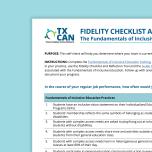
Significant Cognitive Disabilities, Inclusion
Fidelity Checklist and Reflection Tool: The Fundamentals of Inclusive Education
This self-check will help you determine where your team is currently performing in regard to the Fundamentals of Inclusive Education. Complete the Fundamentals of Inclusive Education training and then complete this document to get the baseline for your team. As you move forward in your practice, use
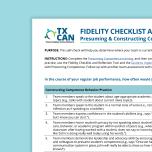
Significant Cognitive Disabilities, Inclusion
Fidelity Checklist and Reflection Tool: Presuming and Constructing Competence
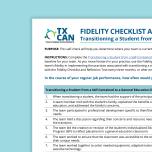
Significant Cognitive Disabilities, Inclusion, Transition
Fidelity Checklist and Reflection Tool: Transitioning a Student from a Self-Contained to a General Education Classroom
This self-check will help you determine where your team is currently performing in regard to transitioning students with complex access needs for inclusion. Complete the Transitioning a Student from a Self-Contained to a General Education Classroom training and then complete this document to get the
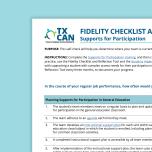
Significant Cognitive Disabilities, Inclusion, Instruction
Fidelity Checklist and Reflection Tool: Supports for Participation
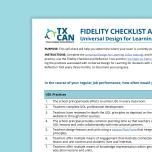
Significant Cognitive Disabilities, Inclusion, Instruction
Fidelity Checklist and Reflection Tool: Universal Design for Learning (UDL)
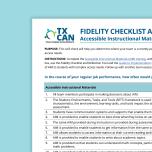
Significant Cognitive Disabilities, Inclusion, Instruction
Fidelity Checklist and Reflection Tool: Accessible Instructional Materials (AIM)
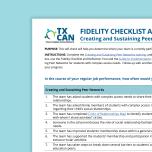
Significant Cognitive Disabilities, Inclusion
Fidelity Checklist and Reflection Tool: Creating and Sustaining Peer Networks

Significant Cognitive Disabilities, Behavior, Instruction, ARD/IEP Supports, Inclusion
Rubric of Effective Practices for Students with Complex Access Needs

Significant Cognitive Disabilities, ARD/IEP Supports
IEP Quality and Rigor Rubric
- Use student data to monitor the effectiveness of supports and inclusive practices.
- Revise Inclusive Education Implementation Plan action items as needed to increase the team's fidelity.
- Identify additional students with significant cognitive disabilities and complex access needs to begin transitioning to a general education classroom.
- Adjust members of the Inclusive Education Implementation Team as needed.
- Each individual student has their own support team (e.g., members of their Admission, Review, and Dismissal Committee, additional campus staff, and other people from the student's relationship circle). Guide these individual student teams in planning supports for student participation in general education, using the Instructional Support Planning Form. Keep the team on track with an Instructional Support Planning Meeting Agenda.
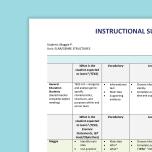
Significant Cognitive Disabilities, Inclusion, Instruction
Instructional Support Planning Form
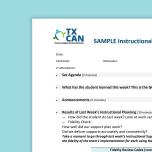
Significant Cognitive Disabilities, Inclusion, Instruction
Instructional Support Meeting Agenda Template
- Facilitate peer support networks for isolated students.
- Recognize staff and student-specific training needs and have appropriate staff engage in this professional development.
- Plan for long-term sustainability of programs and resources.
Revise Action Items
Action items will continue to vary considerably from school to school as teams work through the phases using their Inclusive Education Implementation Plans. Phase Three focuses on continuous reflection and adjustment of action items as needed to increase fidelity and expand inclusive education practices.
Reflection
Using regular fidelity checklists, rubrics, and student data, teams will continuously self-evaluate to acknowledge their growth and evaluate their progress towards inclusive education. The team’s Inclusive Education Implementation Plan will continue to be a fluid document that encompasses improvement, sustainability, and expansion of inclusive education practices.
Expansion
The team will use what they have learned to identify additional students to transition to a general education classroom and continue supporting these transitions moving forward. As team members and school staff may fluctuate over time, team members must commit to advocating for inclusive education by providing “catch up” professional development to any new staff. Ever mindful of the sustainability of programs and resources that support their inclusive education vision, the team considers new ways to use spaces that were previously designated for special education, such as the creation of inclusive support centers for all students (open to any student for remediation, quiet work space, enrichment). Through guidance, coaching, and professional development, the team will look at expanding true inclusive education to all students on the campus and other campuses in the district.
Barriers/Coaching Tips
As teams progress forward through the phases, they may get complacent or become overwhelmed by other campus issues and lose focus on implementing with fidelity.
Other teams may lose momentum over summer break and need to be reengaged as a team prior to the new school year.
Additionally, on campuses with frequent staff turnover, teams may struggle with maintaining the foundational knowledge of the core elements of inclusive education across all staff. A new administration may require guidance and support for allocating resources and managing budgets.
The coach should acknowledge these challenges and assist the team in refocusing on fidelity, using checklists, rubrics, and student data to drive their action items. Guide new staff members through professional development that helps them develop a foundational knowledge of inclusive education – beginning with Presuming Competence and a review of the “Demonstrate Dignity and Value” section from the Guide to Implementation of The Fundamentals of Inclusive Education. Coaches can assist administrators in determining where and how the use of personnel and other resources will most impact student success.
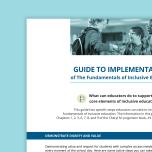
Significant Cognitive Disabilities, Inclusion
